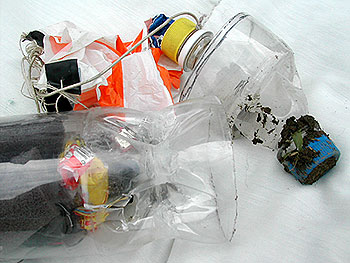Water Rockets
Wireless Water Rocket Camera, part II

Ingredients for this wireless rocket:
- two one liter soda bottles
- Shoe-goo & silicon sealant for rocket assembly
- one x-10 wireless camera & base reciever
- misc. wire, switch, tape, and packing material to assemble camera
- Video camera with external video input (hooked to X10 reciever)
- iMovie to import video over firewire and create movie
The model shown here is the second modular design. On the first one I had glued the two one-liter bottles together, end to end. That worked fine the first couple of shots but broke apart on one of the rougher landings. With this design I've cut the very end of a one-liter bottle off glued it to the bottom of the payload bottle, and that snaps onto the bottom, engine.
Other features of the new rocket design. The "engine" is a stock 1 liter bottle, with a bit of duct and electrical tape for that high tech look. Same fins as the last model. The camera module has undergone much retrofitting in the hope to keep everything firmly anchored in the event of an unchecked high speed descent into terra firma. Finally the rocket nose cone is a clever design by Kirk that I've retrofitted in the hopes that it will help chute deployment. Not quite visible are two large metal nuts in the nose cone to "shake" and "detach" it as the rocket changes direction at apogee. That's the theory.
By the way, the one drawback to modular designs is an increase in weight. Still, even with all of the extra weight we've seen rockets easily reach over two hundred feet, even three. If you are shooting to break an altitude record (currently held by AntiGravity Research, around 1200 feet) you'll be doing a lot more than just shaving a little extra weight.
This was also the first attempt at using a parachute with the camera. I'd like to say that it was a stunning success but in fact the parachute seems to be allergic to X10 wireless cameras (who can blame it?). And it's not like it doesn't deploy, it's that it deploys at about 40 feet above the ground when the rocket is really, really moving. End result: parachute ripped to shreds, rocket slowed way down, wireless camera movie...boring. Make new parachute.
The next launch was a picture perfect shot. The rocket soared into the heavens, steady and purposeful as if this time it might not come back to Earth. Oh, but it did, and how! Once again the parachute and nose cone remained firmly wedded to the rocket and after a smooth arch at apogee it fell like a rock to the ground. Fell like a rock with 9 volt battery and two large nuts inside. It cratered a few inches into our lawn.
A new lawn aeration technique.

The movie is a 170k quicktime of the second launch. Short, but still pretty impressive. For extra points see if you can spot the dog. You can also get the movie here should my fancy embedding not work on your setup.
| «Wireless Water Rocket Camera, part I | Page 10 of 12 | Rocket Recovery Systems» |
